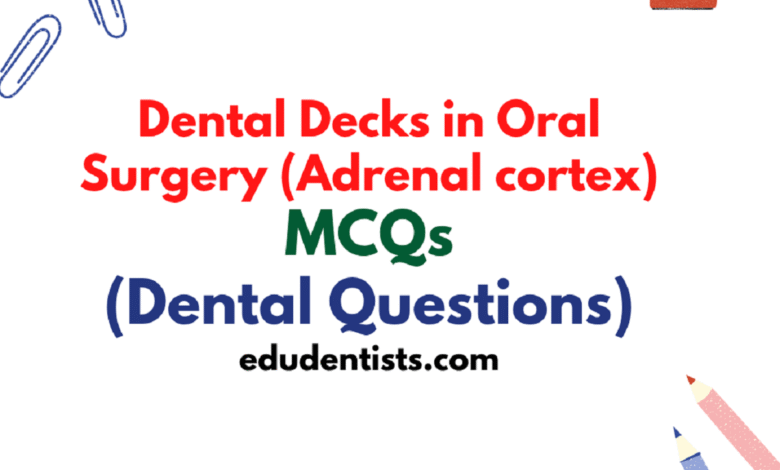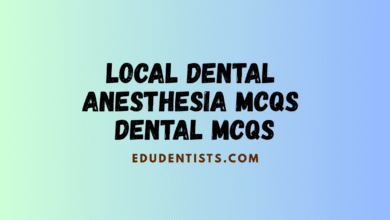Dental Decks in Oral Surgery (Adrenal cortex) _ Dental MCQs

Dental Decks in Oral Surgery (Adrenal cortex) _ Dental MCQs
1. The gold standard test for primary adrenal failure is the:
A. Blood glucose test
B. ACTH stimulation test
C. Serum creatinine level
D. BUN test
ACTH stimulation test is performed to examine the response of the adrenal gland to an exogenously administered dose of ACTH. Normal patients have a doubling of the serum Cortisol level after a dose of ACTH. The serum Cortisol level shouldrise to >20 mg/dL if there is adequate adrenal function. An inadequate response suggests adrenal gland hypofunction. Note: Cosyntropin (Cortrosyn) is an ACTH analogue that stimulates
the adrenal gland and its ACTH receptors.
About 20 mg of hydrocortisone is secreted by the adrenal cortex daily. During stress, the cortex can increase the output to 200 mg daily.
2- A person who has been on suppressive doses of steroids will?
Select all that apply.
A. Take as long as a year to regain full adrenal cortical function
B. Patients experience weakness, weight loss, orthostatic hypotension, nausea, and vomiting.
C. May show signs of hyperpigmentation, result of hypersecretion of ACTH, which stimulate melanocytes to produce pigment.
D. Patients cannot increase steroid production in response to stress and in extreme situations may have cardiovascular collapse.
E. Require consultation with a physician prior to surgery
F. All of the above
The following guidelines may help determine if a patient’s adrenal function is suppressed:
• People on small doses (5 mg prednisone/day) will have suppression when they have been on the regimen for a month.
• People taking the equivalence of 100 mg cortisol/day (20-30 mg prednisone/day) will have abnormal cortical function in a week.
• Short-term therapy (1-3 days) of even high-dose steroids will not alter adrenal cortical function.
• A person who has been on suppressive doses of steroids will take as long as a year to regain full adrenal cortical function.
3- Patients with glucocorticoid hypersecretion have:
A. Ectopic ACTH Syndrome
B. MEN I
C. Cushing syndrome
D. Addison disease
Cushing syndrome is a hormonal disorder caused by prolonged exposure of the body’s tissues to high levels of the hormone Cortisol. This results in characteristic changes in body hiatus, including moon facies, truncal obesity, muscular wasting, and hirsutism. Some times called “hypercortisolism,” it is relatively rare and most commonly affects adults aged 20 to 50. The female-to-male incidence ratio is approximately 5:1.
Patients with Cushing syndrome are often hypertensive because of fluid retention. Longterm glucocorticoid excess can result in decreased collagen production, a tendency to bruise easily, poor wound healing, and osteoporosis. They are often at increased risk for infection.
The most common cause of Cushing syndrome is a tumor in the pituitary gland.
4- A 52-year-old woman requests removal of a painful mandibular second molar. She tells you that she has not rested for 2 days and nights because of the pain. Her medical history is unremarkable, except that she takes 20 mg of prednisone daily for erythema multiforme. How do you treat this patient?
A. Have patient discontinue the prednisone for 2 days prior to the extraction
B. Give steroid supplementation and remove the tooth with local anesthesia and sedation
C. Instruct the patient to take 3 grams of amoxicillin 1 hour prior to extraction
D. No special treatment is necessary prior to extraction
* The fear here is that the patient may not have sufficient adrenal cortex secretion (adrenal in sufficiency) to withstand the stress of an extraction without taking additional steroids. (This holds true for any patient who has been treated with steroid therapy).
* Patients with adrenal insufficiency, patients on daily steroid therapy, and patients who have recently finished a course of steroids should receive steroid supplementation for dental procedures.
* The concerns about adrenal insufficiency should be raised on the basis of clinical history. In the majority of cases, the dentist should ask:
• Is it known that the patient’s adrenal glands do not function adequately?
• Is the patient on chronic steroid therapy at doses of prednisone higher than 15 mg/day?
• Has the patient been on steroid therapy at doses of prednisone higher than 15 mg/day within the last 2 weeks?
*** If the answer to any of the above questions is yes, the dentist should assume that the patient will need stress-dose steroids.
General guidelines for the management of patients on steroid therapy:• Steroid supplementation in patients who can develop adrenal insufficiency
• Early morning appointments
• Shorter appointments
• Minimize stress
• Use sedation techniques when appropriate
• Modify dental treatment plan when appropriate
• The major goal in these patients is to avoid precipitating of adrenal insufficiency
Remember: Erythema multiforme is a hypersensitivity syndrome characterized by polymorphous eruption of skin and mucous membranes. Macules, papules, nodules, vesicles, or bullae and target or (“bull’s-eye-shaped”) lesions are seen. A severe form of this condition is known as Stevens-Johnson syndrome.
These patients may be receiving moderate doses of systemic corticosteroids and therefore may be unable to withstand the stress of an extraction. Consultation with their physician is absolutely necessary before treating these patients.
5- The most common Cause of Cushing syndrome is:
A. Ectopic ACTH Syndrome
B. Pituitary adenoma
C. Adrenal Tumor
D. Iatrogenic
The most common cause of Cushing syndrome is a tumor in the pituitary gland.
6- How much hydrocortisone is secreted by the adrenal cortex daily?
A. About 1mg
B. About 100mg
C. About 20mg
D. About 200mg
During stress, the cortex can increase the output to 200 mg daily.
7- All of the statements below about glucocorticoids are true, except:
A. They function by binding to an extracellular receptor
B. They decrease the production of leukotrienes and prostaglandins
C. Inhibition of phospholipase A2 is a key to their mechanism of action
D. They are contraindicated in Cushing syndrome
E. They are commonly used in inflammation and immunosuppression
8- A female patient presents to your office with facial and torso obesity, facial hair growth, and a deepened voice. The patient explains these changes occurred when she started taking a common drug to treat Crohn’s disease, and subsequently she recently discontinued the drug use. While performing a surgical extraction, the patient suddenly starts breathing at a fast rate, sweating, and complains of nausea and chills. You recognize that the patient is experiencing a crisis and reach for your Emergency Kit. Which of the following contents of your Emergency Kit would be most appropriate to alleviate this crisis?
A. Oxygen
B. Epinephrine
C. Nitroglycerin
D. Sugar
E. Hydrocortisone





